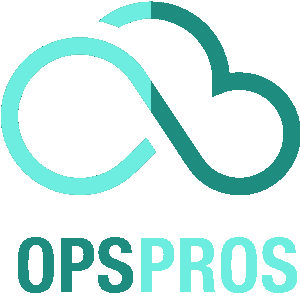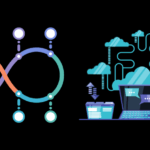How do Agile and DevOps interrelate? Dive into the exciting convergence of these two robust methodologies as we unravel how they supercharge software development, fostering speed, quality, and a culture of innovation.

Brief Explanation of Agile and DevOps
In today’s fast-paced digital world, businesses must stay ahead of the competition by delivering quality software products faster than ever. This is where Agile and DevOps come into play.
Agile is an iterative approach to software development that emphasizes customer collaboration, flexibility, and speed. It involves breaking down complex projects into smaller, manageable tasks that can be completed in short cycles called sprints.
DevOps, on the other hand, is a set of practices that combines software development (Dev) and information technology operations (Ops). Its goal is to streamline the entire software delivery pipeline from planning to deployment by fostering collaboration between teams.
Importance of Understanding Their Interrelation
Agile and DevOps are two approaches that have become increasingly popular in recent years due to their ability to improve software development processes significantly. However, they aren’t mutually exclusive but complement each other well.
Agile focuses on delivering value quickly through iterative development cycles, while DevOps emphasizes automation and continuous delivery. Implementing both successfully requires knowledge of their interrelation.
Understanding how these two approaches work together can significantly impact your organization’s ability to deliver high-quality software products efficiently.
The synergy between these methodologies creates a culture of collaboration among team members from different departments, such as developers, testers, and operations personnel.
Agile and DevOps: What are they?
Agile and DevOps are two of the most popular software development methodologies today. While both share similarities in their approach, they have different objectives, principles, and features. Understanding each methodology is essential for any team to choose the best fit for their project.
Definition of Agile
Agile is a flexible approach to software development that emphasizes collaboration, iterative development, and customer satisfaction. It involves breaking down projects into smaller chunks called sprints that last from one to four weeks.
At the end of each sprint, the team delivers a working product feature or function ready for feedback from stakeholders or customers. Agile aims to develop high-quality software with excellent business value by delivering functionality early and continuously.
Definition of DevOps
DevOps is an approach that emphasizes collaboration between software developers (Dev) and information technology operations (Ops) teams to automate infrastructure deployment, testing, and monitoring processes throughout the entire software life cycle.
It involves implementing continuous integration/continuous delivery (CI/CD) pipelines that enable teams to build, test, deploy, and deliver code changes quickly and reliably in response to changing demands. DevOps aims to improve time-to-market while reducing errors by automating repetitive tasks.
Key features and principles of each approach

Agile has four core values: individuals and interactions over processes and tools; working software over comprehensive documentation; customer collaboration over contract negotiation; responding to change over following a plan.
DevOps has three key components: culture, automation, and measurement.
The culture component focuses on creating an environment where cross-functional teams are encouraged to collaborate, share knowledge, and take ownership of their work. The automation component focuses on building automated workflows that enable teams to deploy code changes quickly and reliably.
The measurement component focuses on establishing metrics to track performance, identify bottlenecks, and improve processes over time.
Agile is an approach that emphasizes flexibility and iterative development, while DevOps is an approach that emphasizes automation and cross-functional collaboration.
Both approaches have unique features and principles that can be beneficial depending on the project’s requirements.
Agile and DevOps: How do they differ?
Differences in Goals and Objectives: Agile and DevOps are similar in many ways but have different goals and objectives. Agile aims to create a flexible, iterative software development process that focuses on delivering valuable features to the customer as quickly as possible.
On the other hand, DevOps aims to improve the overall efficiency of software development by breaking down silos between development, operations, and quality assurance teams. The goals of Agile are achieved through sprints that typically last two weeks.
At the end of each sprint, there is a review meeting where the team demonstrates their work to stakeholders. The goal is to deliver working software at the end of each sprint that meets customer needs.
In contrast, DevOps emphasizes continuous integration and delivery (CI/CD) – releasing minor updates frequently instead of significant releases less often. Differences in Team Structure and Collaboration: Another difference between Agile and DevOps is in team structure.
Agile promotes self-organizing teams of cross-functional members who work closely throughout the development process. This facilitates communication among team members with different skill sets, making problem-solving more efficient.
DevOps also fosters collaboration but breaks down traditional silos between departments by encouraging teams to work together regularly from early stages until deployment through automation tools such as CI/CD pipelines.
Differences in Development Processes: Finally, differences exist in the development processes used by each approach.
Agile relies on an incremental approach where new features are developed iteratively over time. Feedback sessions occur frequently throughout the process, which helps identify issues early before substantial progress.
DevOps employs a more holistic approach emphasizing quick feedback loops that use monitoring tools like APMs (Application Performance Monitoring) or Log Analytics instead of waiting for failures or issues discovered only during testing phases, thus reducing potential downtime during production releases.
Agile and DevOps may share some similarities but differ in goals and objectives, team structure and collaboration, and development processes. Understanding these differences is the key to selecting the right approach for your team and implementing it successfully.
How Agile and Devops Interrelate
Agile and DevOps are two approaches that complement each other quite well. Agile focuses on delivering rapid iterations of working software, while DevOps aims to deliver reliable, secure software faster.
They create a powerful combination to help teams deliver high-quality software more efficiently. One of the key benefits of combining Agile and DevOps is improved communication and collaboration.
By working together, teams can ensure everyone is on the same page regarding project goals, timelines, and priorities. Teams that use both approaches are also better equipped to handle sudden changes or roadblocks since they have established processes for addressing issues quickly.
Another critical aspect of the interrelation between Agile and DevOps is the need for continuous improvement. Both approaches emphasize an iterative approach to development, meaning that teams continually look for ways to improve their processes.
By integrating Agile with DevOps practices such as continuous integration and delivery (CI/CD), teams can continuously test and deploy code changes more efficiently than ever before. Overall, integrating Agile with DevOps is essential for successful software development.
Teams must work closely to ensure efficient communication, collaboration, and continuous improvement through iterative processes. With these strategies, organizations can achieve faster time-to-market while delivering reliable, secure software to their customers.
Benefits of Combining How Agile and Devops Interrelate

Improved Communication, Collaboration, and Efficiency
One of the primary benefits of combining Agile and DevOps is that it leads to improved communication, collaboration, and efficiency. Both approaches emphasize the importance of teamwork and breaking down silos between different departments.
By working together more closely, team members can share knowledge and expertise, identify problems earlier in the development process, and work together to develop solutions.
Additionally, implementing Agile methodologies within a DevOps environment can help teams focus on delivering value quickly to customers. Teams are encouraged to prioritize work based on customer needs and feedback, which helps ensure that the features being developed are aligned with customer expectations.
Faster Time-to-Market
Another benefit of combining Agile and DevOps is that it can result in faster time-to-market for software products. With an Agile approach to development, teams can deliver new features in small increments rather than waiting until all features are complete before delivering a final product.
This approach allows teams to get feedback from customers early on in the process so they can make necessary adjustments before release. DevOps also helps speed up time-to-market by automating specific processes like testing and deployment.
Automated testing helps catch bugs earlier in the development process so they can be fixed quickly. Automated deployment allows teams to release code faster without sacrificing quality.
Enhanced Quality Assurance
By combining Agile with DevOps practices like continuous integration/continuous delivery (CI/CD), teams can enhance their quality assurance efforts throughout the software development lifecycle. Automated testing as part of CI/CD helps identify issues early on so they can be addressed quickly.
Additionally, because Agile and DevOps emphasize collaboration among team members, any issues that arise during development or testing can be identified more quickly through open communication between developers, testers, and other stakeholders.
This leads to a more iterative approach to development where issues are addressed quickly and efficiently, resulting in a higher-quality end product.
Best Practices for Implementing How Agile and Devops Interrelate
Creating a Culture that Fosters Collaboration
One of the most important aspects when implementing Agile with DevOps is to create a culture that fosters collaboration. This means breaking down the silos between development, operations, and testing teams and fostering an environment where everyone works together towards the same goal.
To achieve this, organizations can implement various team-building activities such as team lunches or happy hours, programs encouraging cross-functional training to learn more about each other’s roles and challenges, and regular check-ins on project progress.
Organizations should also encourage team transparency by sharing information about upcoming development initiatives and milestones.
By creating an open dialogue across different departments, everyone involved will better understand what is happening in other areas of the organization and how they can support each other.
Implementing Continuous Integration/Continuous Delivery (CI/CD) Pipelines
Another best practice for implementing Agile with DevOps is implementing Continuous Integration/Continuous Delivery pipelines. This process involves automatically building software as soon as changes are made in code repositories.
The code then goes through automated testing processes before being deployed into production.
A CI/CD pipeline helps ensure that new features or changes do not break existing functionality while also allowing organizations to deploy updates quickly. This approach reduces the risk of downtime during deployment while providing developers with faster feedback on their code changes.
Establishing Metrics to Measure Success

Establishing metrics that measure Agile’s success with DevOps implementations is essential.
These metrics will help organizations determine whether their implementation has been successful by tracking progress towards goals such as faster time-to-market, improved quality assurance, or better collaboration across teams.
Metrics should be regularly reviewed and updated based on stakeholders’ feedback in the implementation process.
For instance, an organization might track metrics such as monthly releases, defects discovered during testing, and the time it takes to deploy new functionality to production.
There are several best practices for implementing Agile with DevOps that organizations can follow to ensure a successful implementation.
Creating a culture that fosters collaboration between teams, implementing Continuous Integration/Continuous Delivery pipelines, and establishing metrics to measure success are critical strategies organizations can use.
By following these best practices, organizations can streamline their development processes while delivering high-quality software more efficiently.
Challenges with How Agile and DevOps Interrelate
Overcoming resistance to change
One of the biggest challenges in combining Agile with DevOps is getting team members to adapt to new processes. Some team members may resist change, mainly if they have used traditional software development methods for a long time.
Leaders must communicate the benefits of integrating Agile and DevOps and how it will help improve the overall development process.
It’s also essential to involve team members in decision-making so they feel their voices are being heard. Another way to overcome resistance is by providing training and resources.
This could be through workshops, online courses, or one-on-one coaching sessions. Team members must understand how the new processes work and why they are effective.
Leaders must lead by example. If leaders embrace change and demonstrate their commitment to Agile and DevOps principles, others on the team will likely follow suit.
Ensuring proper training for team members
Merging Agile and DevOps brings a challenge: proper training for all team members. This covers technical and soft skills. Communication and collaboration are essential.
One effective training method is through cross-functional teams. People from different departments work on a project together. They learn from each other. They understand how the development process elements connect.
Continuous education and training programs are crucial. They keep employees updated on Agile and DevOps developments. Training shouldn’t be a one-time event. It should be ongoing.
By investing in employee development, companies equip their teams for success. They always have the needed skills.
Recap about How to Do Agile and Devops Interrelate
Agile and DevOps have transformed software development. It’s essential to understand their interaction. Agile highlights flexibility, quick iteration, customer satisfaction, and teamwork.
In contrast, DevOps promotes automation, CI/CD, and collaboration between developers and operations. It also emphasizes Infrastructure as Code (IaC) and feedback loops. These approaches enhance each other. They aim to improve software quality, cutting costs and time-to-market.
Understanding the Agile-DevOps link is crucial. It helps prevent conflicts between different methodology teams. Agile-focused developers may get frustrated if operations teams ignore their requests or if deployment issues arise.
Operations teams may see developers as careless if they overlook security or scalability. Comprehending the Agile-DevOps link is also essential for continuous improvement.
It eliminates department barriers and promotes cross-function cooperation. This lets companies identify and optimize process bottlenecks faster. Feedback loops involving end-users and all stakeholders improve product usability. They align products with business goals.
Final thoughts about How to Do Agile and Devops Interrelate
To use Agile and DevOps, you need technical skills and change management abilities. Also, metrics-based decision-making is crucial. Tools like JIRA or Trello can help in tracking tasks. For DevOps, choose a suitable CI/CD tool. Jenkins or CircleCI could be options. These tools help automate testing, building, and deployment.
This ensures that changes are made quickly and without human error. Implementing Agile requires a well-structured product backlog where the team can prioritize features that must be developed.
Furthermore, an Agile coach can help facilitate sprint planning meetings and support the team in keeping their eye on business goals while avoiding technical debt. Creating a continuous improvement and transparency culture is essential to measuring key metrics such as lead time, cycle time, and mean time to resolution (MTTR).
These metrics provide insights into how well your teams are performing and help you identify areas for improvement. Overall, Agile-DevOps interrelation is an essential aspect of modern software development practices.
These two methods help make high-quality products. They meet customer needs while cutting costs and time-to-market. Companies should use best practices for both methods. This can improve their development process efficiency. It also promotes teamwork and innovation.
Noah is an accomplished technical author specializing in Operations and DevOps, driven by a passion ignited during his tenure at eBay in 2000. With over two decades of experience, Noah shares his transformative knowledge and insights with the community.
Residing in a charming London townhouse, he finds inspiration in the vibrant energy of the city. From his cozy writing den, overlooking bustling streets, Noah immerses himself in the evolving landscape of software development, operations, and technology. Noah’s impressive professional journey includes key roles at IBM and Microsoft, enriching his understanding of software development and operations.
Driven by insatiable curiosity, Noah stays at the forefront of technological advancements, exploring emerging trends in Operations and DevOps. Through engaging publications, he empowers professionals to navigate the complexities of development operations with confidence.
With experience, passion, and a commitment to excellence, Noah is a trusted voice in the Operations and DevOps community. Dedicated to unlocking the potential of this dynamic field, he inspires others to embrace its transformative power.







